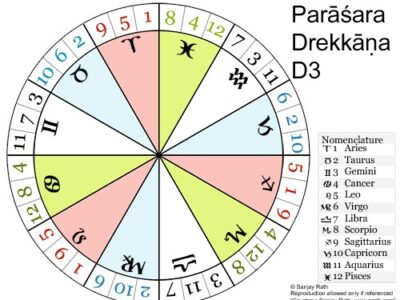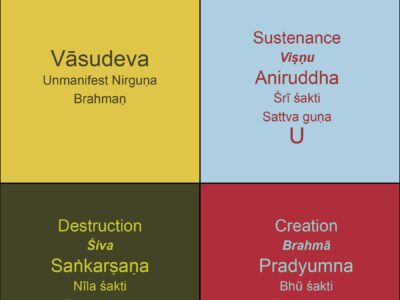लाभभावफलाञ्चाथ कथयामि द्विजोत्तम। श्रुयोताम् जातको लोके यछुत्भत्वे सदा सुखी॥ lābhabhāvaphalāṣcātha kathayāmi dvijottama | śruyotām jātako loke yachutbhatve sadā sukhī || -Bṛhat Parāśara Horā Śāstra, Lābhabhāvaphalādhyāya, Sl. 1 “O the greatest among dvijas, I will now tell you about the results of Lābha Bhāva, which if auspicious (śubha) will make the native eternally happy” The…
ऐं क्लीं ह्रीं त्रिपुरेशि भगवति स्वाहा
The Fifth House The pancama bhāva or the fifth house is the place of the working of the buddhi and is the seat of the mana, representing its highest level. In the natural zodiac, the fifth house is ruled by the Sun, and hence it reflects it’s glorious persona, with the fifth lord promoting the Sun’s qualities, in advancing supreme knowledge and wisdom. It represents a person’s dhī, intelligence,…
General Principles The main principles, which should be kept in mind while analysing divisional charts, are the kārya rāśi, kāryeśa and the kāraka. Kārya rāśi is the sign of the house, which is the significator of the ruling activity. Kāryeśa is the lord of the concerned house in the rāśi chart. This lord will have to…
The varga charts are clustered in separate groups or schemes for purposes of specific predictions, such as ṣaḍvarga, saptavarga, daśavarga, ṣoḍaṣavarga and aṣṭākavarga. Ṣaḍvarga is a group used in Praśna including the following six divisions: Rāśi, Horā, Drekkāṇa, Navāṁśa, Dvādaśāṁśa and Triṁśāṁśa. The saptavarga clusters, used for mundane astrology, include Rāśi, Horā, Drekkāṇa, Saptāṁśa, Navāṁśa, Dvādaśāṁśa and Triṁśāṁśa. Daśavarga is used universally in horoscopy comprising Rāśi, Horā, Drekkāṇa, Saptāṁśa, Navāṁśa, Daśāṁśa, Dvādaśāṁśa, Ṣoḍaṣāṁśa, Triṁśāṁśa and Ṣaṣṭiāṁśa. Finally ṣoḍaṣavarga, the varga scheme adopted by Parāśara and commonly followed in predictive astrology include the following divisions Rāśi, Horā, Drekkāṇa, Chaturthāṁśa, Saptāṁśa, Navāṁśa, Daśāṁśa, Dvādaśāṁśa, Ṣoḍaśāṁśa, Viṁśāṁśa, Chaturviṁśāṁśa, Nakṣatrāṁśa, Triṁśāṁśa, Khavedāṁśa, Akṣavedāṁśa and Ṣaṣṭiāṁśa. Originally the ṣoḍaṣavargīya scheme was reserved for…
The twelve signs therefore, are divided and sub-divided in different fractions, the sequence of which gets repeated after every twelve divisions. Each cycle of twelve divisions represent a ‘harmonic’ depicting the various levels of consciousness, both gross and subtle, which exists in the life of a person. The first cycle of divisional charts from D-1 to D-12 represent the physical plane. They cover the various aspects of the physical realities of a person such as the…
एकोऽव्यक्तात्मको विष्णुर्नादिः प्रभुरीश्वरः। शुद्धसत्व जगत्स्वामी निर्गुणास्त्रिगुणान्वितः॥ eko’vyaktātmako viṣṇurnādiḥ prabhurīśvaraḥ| śuddhasatvao jagatsvāmī nirguṇāstriguṇānvitaḥ|| Bṛhat Parāśara Horā Śāśtra, sṛṣṭikramakathanādhyāya, śloka 13 The Beginning In the beginning there was the great Void. The five primordial elements or the pañca bhūtas, the fourteen lokas or the caturdaśa bhuvanas, the Universe, dyu and Space, water and air, sound, and light nothing existed. There was neither death nor life, no day nor night, neither beginning nor end. There existed only the one Brahmaṇ, immersed in the mire of dark ignorance and undivided…
Divisional charts are the keys to understanding horoscopes as they unlock that hidden door which refuses to open, even after the astrologer has examined the entire spectrum of variables for analyzing a bhāva. So once a bhāva has been put under the gaze, and its rāśi and the planets housing it and aspecting it, its lord and its dispositor, its strengths and its Navāṁśa, its ārūḍha padas and special lagnas, its kārakas and yogas, argalās and dṛṣṭis, have all been inspected from every…
Parāśara, in his monumental work, the Bṛhat Parāśara Horā Śāstra has identified two categories of celestial bodies, moving (cara) and non-moving (sthira). The moving bodies are the planets (grahas) comprising our solar system, namely, the Sun (Sūrya), Moon (Candra), Mercury (Budha), Mars (Maṅgal), Venus (Śukra), Jupiter (Bṛhaspati) and Saturn (Śani). The sun is included in the category of grahas, despite the fact it actually does not move and is in fact a star. The sun and…
Sandhi or the transition zone between one bhāva and another and between two rāśis, is a problematic field of study in jyotish. It is a nebulous area where astrologers have so far failed to throw light on the reasons behind the peculiar nature of planets in sandhi and their effects on people’s lives. Being transitional in nature, sandhis are fuzzy and grey areas and planets placed in them are extremely…


